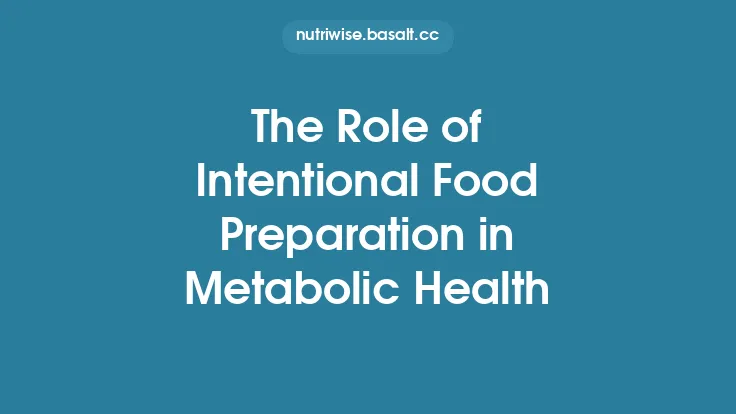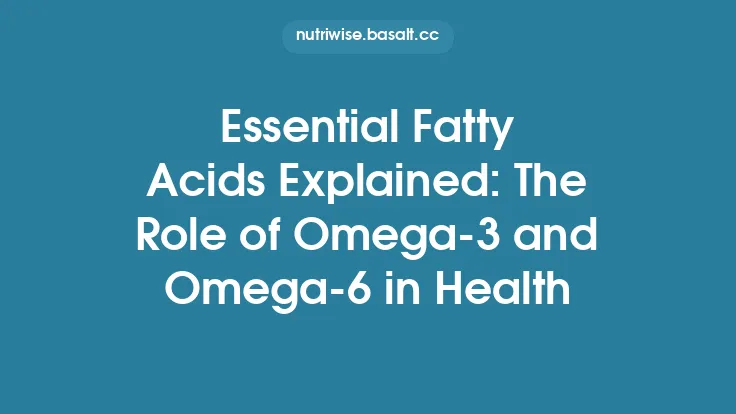Nutrient bioavailability—the proportion of a nutrient that is released from the food matrix, absorbed across the intestinal wall, and ultimately utilized by the body—is a cornerstone of nutritional science. While the intrinsic composition of a food determines the theoretical amount of a nutrient it contains, the actual physiological benefit hinges on how that nutrient is presented to the digestive system. Food processing, encompassing everything from simple mechanical size reduction to sophisticated high‑pressure treatments, can dramatically reshape the physical and chemical landscape of foods, thereby modulating the accessibility of nutrients. Understanding these transformations is essential for food scientists, technologists, and health professionals who aim to design products that deliver optimal nutritional value throughout the supply chain.
Defining Food Processing and Its Spectrum
Food processing is any deliberate alteration of raw agricultural commodities to improve safety, shelf‑life, palatability, or convenience. It can be broadly categorized into:
| Category | Typical Operations | Primary Effect on Food Structure |
|---|---|---|
| Mechanical | Milling, grinding, extrusion, shearing | Disruption of cellular walls, reduction of particle size, creation of new surface area |
| Thermal | Pasteurization, sterilization, blanching, roasting | Denaturation of proteins, gelatinization of starches, inactivation of enzymes, formation of new compounds (e.g., Maillard products) |
| Non‑thermal | High‑pressure processing (HPP), pulsed electric fields (PEF), cold plasma, irradiation | Alteration of cell membranes and macromolecular conformation without substantial heat input |
| Drying & Dehydration | Spray‑drying, freeze‑drying, drum drying | Removal of water, concentration of solids, potential oxidative changes |
| Bioprocessing | Fermentation, enzymatic treatment, controlled sprouting | Microbial metabolism that can synthesize, degrade, or transform nutrients |
Each of these operations can either enhance or diminish the bioavailability of specific nutrients, depending on the nature of the food matrix and the processing parameters employed.
Physical Disruption of the Food Matrix
The most immediate consequence of mechanical processing is the breakdown of the structural barriers that encase nutrients. In intact plant cells, for example, phytochemicals, minerals, and some vitamins are sequestered within vacuoles or bound to cell wall polysaccharides. Grinding or milling reduces particle size, increasing the exposed surface area and shortening the diffusion path for digestive enzymes. This effect is especially pronounced for:
- Starch – Mechanical disruption facilitates gelatinization during subsequent heating, making glucose units more readily accessible to amylases.
- Lipid droplets – Homogenization creates smaller oil droplets, which are more efficiently emulsified by bile salts, improving the micellar solubilization of fat‑soluble vitamins.
- Protein aggregates – Size reduction can expose previously hidden peptide bonds, allowing proteases to act more efficiently.
However, excessive mechanical force can also generate dense, compacted structures (e.g., high‑pressure extrusion) that trap nutrients within a matrix of denatured proteins and retrograded starch, potentially limiting accessibility.
Chemical Transformations Induced by Processing
Processing often triggers a cascade of chemical reactions that reshape nutrient forms:
- Maillard Reactions – Non‑enzymatic browning between reducing sugars and amino acids creates melanoidins. While some melanoidins possess antioxidant activity, the reaction can also bind essential amino acids (e.g., lysine) and reduce their bioavailability.
- Oxidation – Exposure to heat, light, or oxygen can oxidize polyunsaturated fatty acids (PUFAs) and fat‑soluble vitamins (A, D, E, K), forming less bioactive or even harmful metabolites. Antioxidant addition or inert atmospheres can mitigate these losses.
- Isomerization – Thermal processing can convert trans‑fatty acids to cis‑forms or alter the stereochemistry of certain vitamins (e.g., conversion of β‑carotene to other carotenoids), influencing absorption efficiency.
- Complex Formation – Heat can promote the binding of minerals to phytates or oxalates, reducing solubility. Conversely, certain processes (e.g., fermentation) can degrade these antinutrients, liberating the bound minerals.
The net impact of these reactions depends on processing intensity, duration, and the presence of protective agents (e.g., natural antioxidants, chelators).
Enzyme Inactivation and Its Consequences
Raw foods contain endogenous enzymes that can either aid or hinder nutrient availability. For instance, lipases may hydrolyze triglycerides prematurely, while proteases can begin protein breakdown before ingestion. Thermal and non‑thermal treatments inactivate these enzymes, offering two major benefits:
- Stabilization of Labile Nutrients – By halting oxidative enzymes (e.g., polyphenol oxidase), processing preserves phenolic compounds and color pigments that are otherwise degraded.
- Prevention of Antinutrient Activity – Enzymes such as phytase, which hydrolyzes phytic acid, are often inactivated during high‑temperature processing, potentially reducing the release of bound minerals unless the process is specifically designed to retain phytase activity (e.g., low‑temperature sprouting).
Strategic control of enzyme inactivation is therefore a key lever for modulating nutrient bioavailability.
Impact on Specific Nutrient Classes
Proteins
Denaturation—unfolding of the native protein structure—occurs readily under heat, high pressure, or extreme pH. Denatured proteins expose peptide bonds, making them more susceptible to proteolysis, which can increase amino acid absorption. However, excessive denaturation may lead to aggregation via disulfide cross‑linking, forming insoluble complexes that resist enzymatic digestion. Processing methods such as controlled enzymatic hydrolysis or mild high‑pressure treatment can strike a balance, enhancing digestibility without promoting aggregation.
Lipids
Mechanical emulsification and homogenization reduce droplet size, facilitating the formation of mixed micelles essential for the absorption of fatty acids and fat‑soluble vitamins. Thermal oxidation, on the other hand, can generate lipid peroxides that impair micelle formation and may damage intestinal mucosa. Antioxidant fortification (e.g., tocopherols) during processing can preserve lipid integrity.
Carbohydrates
Starch gelatinization—swelling of granules in the presence of water and heat—dramatically improves the accessibility of α‑amylase. Conversely, retrogradation during cooling can re‑crystallize amylose, forming resistant starch that resists digestion. Processing sequences that include rapid cooling (e.g., flash freezing) can limit retrogradation, preserving digestible starch fractions.
Minerals
Processing can both liberate and sequester minerals. Thermal treatments that degrade phytates or oxalates increase the solubility of calcium, iron, and zinc. Yet, high‑temperature drying may cause mineral migration to the surface, where they become more prone to leaching during rehydration. Encapsulation techniques (e.g., spray‑drying with maltodextrin) can protect minerals from loss while still allowing release in the gastrointestinal tract.
Vitamins
Water‑soluble vitamins (B‑complex, C) are highly sensitive to heat and oxidation. Short‑time, high‑temperature processes (e.g., flash pasteurization) can inactivate pathogens while preserving vitamin content. Fat‑soluble vitamins benefit from emulsification and protective carriers; microencapsulation using liposomes or protein‑based nanoparticles can shield them from oxidative degradation and improve micellar incorporation during digestion.
Phytochemicals
Polyphenols, carotenoids, and glucosinolates often exist bound to cell wall components. Mechanical disruption and mild heat can release these compounds, enhancing their bioaccessibility. However, prolonged heating may degrade thermolabile phytochemicals or convert them into less active forms. Non‑thermal technologies like PEF can increase cell membrane permeability, liberating phytochemicals without significant thermal loss.
Processing Technologies and Their Distinct Effects
| Technology | Core Principle | Typical Parameter Range | Primary Nutrient Impact |
|---|---|---|---|
| Pasteurization | Heat (≈ 60–85 °C) for short time | 15–30 s (HTST) | Inactivates enzymes, modest loss of heat‑sensitive vitamins |
| Sterilization | High heat (≥ 121 °C) for extended time | 2–5 min (retort) | Strong microbial kill, significant degradation of labile nutrients |
| High‑Pressure Processing (HPP) | Hydrostatic pressure (300–600 MPa) | 1–15 min, ambient temperature | Preserves heat‑sensitive vitamins, alters protein conformation, improves lipid emulsification |
| Pulsed Electric Fields (PEF) | Short high‑voltage pulses (≥ 20 kV/cm) | µs‑ms duration | Increases cell membrane permeability, releases intracellular nutrients |
| Extrusion | Combined shear, heat, and pressure | 100–200 °C, 50–150 MPa | Gelatinizes starch, denatures proteins, can form resistant starch if cooled rapidly |
| Fermentation | Microbial metabolism (lactic acid bacteria, yeasts) | 24–72 h, 30–37 °C | Degrades antinutrients, synthesizes B‑vitamins, modifies protein digestibility |
| Spray‑Drying | Atomization of liquid feed into hot air | Inlet 150–200 °C, outlet 80–100 °C | Rapid water removal, encapsulation of sensitive nutrients, potential surface oxidation |
| Freeze‑Drying (Lyophilization) | Sublimation of ice under vacuum | Primary drying −30 to −40 °C | Excellent retention of heat‑labile vitamins, preserves porous structure for rehydration |
Choosing the appropriate technology—and fine‑tuning its parameters—allows food developers to target specific nutrient outcomes.
Strategies to Preserve or Enhance Bioavailability
- Controlled Maillard Reaction – Limiting reaction time or temperature can prevent excessive amino acid binding while still generating desirable flavor compounds.
- Antioxidant Fortification – Adding natural antioxidants (e.g., rosemary extract, ascorbic acid) during processing can curb oxidative loss of PUFAs and fat‑soluble vitamins.
- Microencapsulation – Encasing sensitive nutrients in biopolymer matrices (e.g., alginate, whey protein) protects them from heat, oxygen, and light, releasing them only upon gastrointestinal triggers (pH change, enzymatic action).
- pH Adjustment – Slightly acidic conditions during thermal processing can stabilize vitamin C and certain B‑vitamins, reducing degradation rates.
- Sequential Processing – Combining a mild non‑thermal step (e.g., HPP) with a brief heat treatment can achieve microbial safety while preserving nutrient integrity.
- Use of Enzyme‑Retaining Conditions – For foods where endogenous phytase activity is beneficial (e.g., whole‑grain flours), low‑temperature soaking or germination before heat treatment can maintain phytase, thereby enhancing mineral release.
Evaluating Bioavailability: In Vitro and In Vivo Approaches
- In Vitro Digestion Models – Simulated gastrointestinal systems (e.g., INFOGEST protocol) replicate oral, gastric, and intestinal phases, allowing measurement of soluble nutrient fractions post‑processing. These models are valuable for rapid screening of processing variables.
- Caco‑2 Cell Uptake Assays – Human intestinal epithelial cell monolayers assess transepithelial transport of nutrients, providing insight into absorption potential.
- Animal Feeding Trials – Rodent or swine studies remain the gold standard for whole‑body bioavailability, capturing post‑absorptive metabolism and tissue deposition.
- Human Stable‑Isotope Studies – Administering isotopically labeled nutrients in processed foods enables precise quantification of absorption and utilization in volunteers.
Combining these methodologies offers a comprehensive picture, from mechanistic release to systemic utilization.
Future Directions and Emerging Technologies
The next wave of food processing innovations aims to tailor nutrient bioavailability at the molecular level:
- Precision Fermentation – Engineered microbial consortia can produce targeted enzymes (e.g., phytases, proteases) in situ, dynamically modulating antinutrient levels during processing.
- 3D Food Printing – Layer‑by‑layer deposition allows spatial control of nutrient placement, potentially creating micro‑environments that favor selective release during digestion.
- Nanostructured Delivery Systems – Lipid‑based nanocarriers, polymeric nanoparticles, and solid‑lipid particles are being integrated into processing streams to protect and target nutrients to specific intestinal sites.
- Artificial Intelligence‑Driven Process Optimization – Machine‑learning models can predict the impact of processing parameters on nutrient stability, enabling real‑time adjustments to maximize bioavailability while maintaining safety and sensory quality.
These advances promise to shift food processing from a bulk‑scale operation to a precision tool for nutrition.
In sum, food processing is a double‑edged sword for nutrient bioavailability. By dissecting the physical, chemical, and enzymatic alterations that occur during each processing step, scientists can strategically design operations that unlock nutrients, safeguard their integrity, and deliver them efficiently to the consumer’s body. The challenge lies in balancing safety, shelf‑life, and sensory appeal with the nuanced biochemical pathways that govern absorption—a balance that modern food science is increasingly equipped to achieve.





